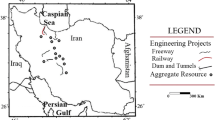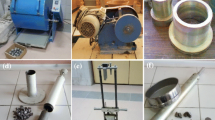Abstract
With an ever-decreasing source of aggregate, this study reports laboratory tests on geologically young material, some of which is unconsolidated, in order to determine whether they can be used as aggregates. Los Angeles abrasion and aggregate impact values were compared and correlations made between these parameters and the petrographic composition of the material, as well as some other common properties (particle shape, water absorption). The drift deposits tested consisted mainly of limestone gravels although clasts of sandstone with some deleterious chert and fine material were also present. Whilst the laboratory test results did not always conform to the requirements of the common Standards for aggregates, it was considered that, with appropriate processing, many of the materials could be used.
Résumé
L’importance d’une sélection rigoureuse des types de roches utilisées en revêtement de façade est soulignée. Une méthode simple et opérationnelle de définition de l’aptitude de certains types de roche à être utilisées comme plaques de revêtement de façade est présentée, avec vérification des performances du dispositif. Les résultats obtenus démontrent l’applicabilité de la méthode. Un logiciel permet de simuler correctement le comportement des plaques de revêtement dans les conditions de l’étude, avec détermination des dimensions adéquates de ces plaques de revêtement et vérification des caractéristiques de résistance de l’accrochage au support.








Similar content being viewed by others
References
Al-Harthi AA (2001) A field index to determine the strength characteristics of crushed aggregate. Bull Eng Geol Environ 60:193–200
Al-Harthi AA, Abo-Saada YE (1997) Wadi natural aggregates in western Saudi Arabia for use in concrete. Bull Int Assoc Eng Geol 55:125–135
Al-Harthi AA, Amin AA (1999) Natural aggregates at Makkah governate, western Saudi Arabia. Bull Eng Geol Env 57:343–352
American Society for Testing and Materials (1997) Annual book of ASTM Standards, Part 4.02, Philadelphia
American Society for Testing and Materials (2002) Standard test method for sand equivalent value of soils and fine aggregate, D 2419–01, Annual Book of ASTM Standards, 4.03, Philadelphia
Bliss JD, Moyle PR, Bolm KS (2003) Statistical, economic and other tools for assessing natural aggregate. Bull Eng Geol Environ 62:71–75
Brand EW, Maunder CA, Massey JB (1984) Aggregates in Hong Kong. Bull Int Assoc Eng Geol 29:11–16
British Standards Institute (1985) Methods for determination of Flakiness index, BS 812.105.1, London
British Standards Institute (1990a) Methods for determination of Elongation index, BS 812.105.2, London
British Standards Institute (1990b) Methods for determination of Aggregate Impact Value, BS 812.112, London
Chang FK (1973) A study of the aggregate impact test in relation to aggregate in Thailand. MSc Thesis, Asian Institute of Technology, Bangkok
De Mulder EFJ (1984) A geological approach to traditional and alternative aggregates in the Netherlands. Bull Int Assoc Eng Geol 29:49–58
Dhir RK, Ramsay DM, Balfour N (1971) A study of the aggregate impact and crushing value tests. J Ins Highway Eng 18:17–27
Doutsos T, Kokkalas S (2001) Stress and deformation patterns in the Aegean region. J Struct Geol 23:455–472
Goswami SC (1984) Quarrying of aggregates in and around Gauhati: impact on the environment. Bull Int Assoc Eng Geol 29:265–268
Ferentinos G, Brooks M, Doutsos T (1985) Quaternary tectonics in the Gulf of Patras, Western Greece. J Struct Geol 7:713–717
French WJ (1991) Concrete petrography: a review. Q J Eng Geol 24:17–48
Fookes PG, Dearman WR, Franklin JA (1971) Some engineering aspects of rock weathering with field examples from Dartmoor and elsewhere. Q J Eng Geol 4:39–85
Hamad BS, Khoury GR, Khawlie MR (2000) Geology and location of major coarse aggregate resources in Lebanon, Eastern Mediterranean. Bull Eng Geol Environ 58:183–190
Hartley A (1974) A review of the geological factors influencing the mechanical properties of road surface aggregates. Q J Eng Geol 7:69–100
Irfan TY (1994) Aggregate properties and resources of granitic rocks for use in concrete in Hong Kong. Q J Eng Geol 27:25–28
Kazi A, Al-Mansour ZR (1980) Influence of geological factors on abrasion and soundness characteristics of aggregates. Eng Geol 15:195–203
Kazi A, Al-Molki ME (1982) Empirical relationship between Los Angeles abrasion and aggregate Impact Value tests. In: Proceedings of the 4th IAEG congress, 6:293–299
Kontopoulos N, Doutsos T (1985) Sedimentology and tectonic of the Antirrion area (Western Greece). Bull Geol Soc It 104:479–489
Korkanç M, Tuğrul A (2004) Evaluation of selected basalts from Niğde, Turkey, as source of concrete aggregate. Eng Geol 75(3–4):291–307
Koukis G, Rozos D (1990) Geotechnical properties of the Neogene sediments in the NW Peloponnesus, Greece. In: Proceedings of the 6th IAEG Congress, Rotterdam pp 405–412
Koukouvelas I, Doutsos T (1996) Implications of structural segmentation during earthquakes: the 1995 Egion earthquake, Gulf of Corinth, Greece. J Struc Geol 18:1381–1388
Langer WH (2002) Managing and protecting aggregates resources. USGS OF Report 02–415
Langer WH, Tucker ML (2003) Specification aggregate quarry expansion—a case study demonstrating sustainable management of natural aggregate resources. USGS OF Report 03–121
Lees G, Kennedy CK (1975) Quality, shape and degradation of aggregates. Q J Eng Geol 8:28–35
Ramsay DM (1965) Factors influencing aggregate impact value in rock aggregate. Quarry Man J 49:129–134
Ramsay DM, Dhir RK, Spence IM (1974) The role of rock and clast fabric in the physical performance of crushed-rock aggregate. Eng Geol 8:267–285
Shakoor A, West TR, Scholer CF (1982) Physical characteristics of some Indiana argillaceous carbonates regarding their freeze-thaw resistance in concrete. Bull Int Assoc Eng Geol 19(4):371–384
Smith MR, Collis L (2001) Aggregates: Sand, gravel and crushed rock aggregates for construction purposes, Sp Pub 17. Geological Society, London, pp 339
Sabatakakis N, Koukis G, Spyropoulos A (2005) Quality assessment of Pleio–Pleistocene and recent Quaternary coarse grained sediments as aggregates for road construction. In: Proceedings of the international symposium GEOLINE 2005:geology and linear infrastructures, Lyon, p 7
Spyropoulos (2005) Study of the engineering geological conditions in Achaia’s prefecture (SW Greece) regarding the use of geological materials as aggregates for various purposes. PhD Thesis, Department of Geology, University of Patras (in Greek with English and French summary), p 306
Stefatos A, Papatheodorou G, Ferentinos G, Leeder M, Collier R (2002) Seismic reflection imaging of active offshore faults in the Gulf of Corinth: their seismotectonic significance. Bas Res 14:487–502
Tasong WA, Cripps JC, Lynsdale CJ (1998) Aggregate-cement chemical interactions. Cem Con Res 28(7):1037–1048
Zarif IH, Tuğrul A (2003) Aggregate properties of Devonian limestones for use in concrete in Istanbul, Turkey. Bul Eng Geol Environ 62:379–388
Zelilidis A, Koukouvelas I, Doutsos T (1988) Neogene paleostress changes behind the forearc fold belt in the Patraikos Gulf area, western Greece”. N Jb Geol Palaont Mh 5:311–325
Wakizaka Y (2000) Alkali-silica reactivity of Japanese rocks. Eng Geol 56:211–221
Acknowledgments
This work was carried out in the frame of “Karatheodoris” research programme provided by the Research Committee of the University of Patras. The authors wish to express their sincere appreciation for the generous support.
Author information
Authors and Affiliations
Corresponding author
Rights and permissions
About this article
Cite this article
Koukis, G., Sabatakakis, N. & Spyropoulos, A. Resistance variation of low-quality aggregates. Bull Eng Geol Environ 66, 457–466 (2007). https://doi.org/10.1007/s10064-007-0098-x
Received:
Accepted:
Published:
Issue Date:
DOI: https://doi.org/10.1007/s10064-007-0098-x




